Confiscated French love letters finally opened after 265 years
ANOTHER AMAZING FIND IN THE MUSEUM STORAGE ROOM
By AFP
November 6, 2023

Cambridge University professor Renaud Morieux unearthed the undelivered and unread letters at the National Archives in Kew - Copyright POOL/AFP JONATHAN ERNST
Helen ROWE
Undelivered letters written to French sailors during an 18th century war between Britain and France have finally been opened and studied — after more than 250 years gathering dust.
The unread letters have provided a rare insight into the lives of sailors and their families in the 1700s, from the wife of a senior naval officer to an elderly mother chastising her son for not writing.
The Royal Navy seized the messages during the Seven Years’ War, a global conflict that ended in 1763 that saw Britain and France lead rival alliances.
“I could spend the night writing to you… I am your forever faithful wife,” wrote Marie Dubosc to her husband Louis Chamberlain, the first lieutenant of a French warship in 1758.
“Good night, my dear friend. It is midnight. I think it is time for me to rest.”
Unknown to Marie, her husband’s ship, the Galatee, had been captured by the British, researchers at the University of Cambridge found.
Louis never received the letter and his wife died the following year, almost certainly before he was released by the British.
In another missive dated January 27, 1758, the mother of young sailor Nicolas Quesnel from Normandy takes him to task about his lack of communication.
“I think more about you than you about me… In any case I wish you a happy new year filled with blessings of the Lord,” 61-year-old Marguerite wrote in a letter probably dictated to someone else.
“I think I am for the tomb, I have been ill for three weeks. Give my compliments to Varin (a shipmate), it is only his wife who gives me your news,” she added.
The Galatee was captured by the British en route from Bordeaux to Quebec in 1758.
– ‘Universal human experiences’ –
British Admiralty officials at the time deemed the letters of no military significance and the vast majority languished in the archives, unopened, until they attracted the attention of Cambridge history professor Renaud Morieux.
“I only ordered the box out of curiosity,” said Morieux, whose findings were published on Tuesday in the journal “Annales. Histoire, Sciences Sociales”.
Presented with three piles of very small letters held together by ribbon, Morieux said he “realised I was the first person to read these very personal messages since they were written”.
“Their intended recipients didn’t get that chance. It was very emotional,” he said.
Morieux identified every member of the Galatee’s 181-strong crew, with letters addressed to a quarter of them, and also carried out genealogical research into the men and their correspondents.
In 1758 alone a third of France’s sailors were captured by the British.
Over the whole period of the Seven Years’ War nearly 65,000 were imprisoned by the British.
Some died from disease and malnutrition although others were released.
Letters would have been the only means their families had of trying to contact them, said Morieux.
“These letters are about universal human experiences, they’re not unique to France or the 18th century,” he added.
“They reveal how we all cope with major life challenges.
“When we are separated from loved ones by events beyond our control like the pandemic or wars, we have to work out how to stay in touch, how to reassure, care for people and keep the passion alive,” said the historian.
“Today we have Zoom and WhatsApp. In the 18th century, people only had letters but what they wrote about feels very familiar.”
Helen ROWE
Undelivered letters written to French sailors during an 18th century war between Britain and France have finally been opened and studied — after more than 250 years gathering dust.
The unread letters have provided a rare insight into the lives of sailors and their families in the 1700s, from the wife of a senior naval officer to an elderly mother chastising her son for not writing.
The Royal Navy seized the messages during the Seven Years’ War, a global conflict that ended in 1763 that saw Britain and France lead rival alliances.
“I could spend the night writing to you… I am your forever faithful wife,” wrote Marie Dubosc to her husband Louis Chamberlain, the first lieutenant of a French warship in 1758.
“Good night, my dear friend. It is midnight. I think it is time for me to rest.”
Unknown to Marie, her husband’s ship, the Galatee, had been captured by the British, researchers at the University of Cambridge found.
Louis never received the letter and his wife died the following year, almost certainly before he was released by the British.
In another missive dated January 27, 1758, the mother of young sailor Nicolas Quesnel from Normandy takes him to task about his lack of communication.
“I think more about you than you about me… In any case I wish you a happy new year filled with blessings of the Lord,” 61-year-old Marguerite wrote in a letter probably dictated to someone else.
“I think I am for the tomb, I have been ill for three weeks. Give my compliments to Varin (a shipmate), it is only his wife who gives me your news,” she added.
The Galatee was captured by the British en route from Bordeaux to Quebec in 1758.
– ‘Universal human experiences’ –
British Admiralty officials at the time deemed the letters of no military significance and the vast majority languished in the archives, unopened, until they attracted the attention of Cambridge history professor Renaud Morieux.
“I only ordered the box out of curiosity,” said Morieux, whose findings were published on Tuesday in the journal “Annales. Histoire, Sciences Sociales”.
Presented with three piles of very small letters held together by ribbon, Morieux said he “realised I was the first person to read these very personal messages since they were written”.
“Their intended recipients didn’t get that chance. It was very emotional,” he said.
Morieux identified every member of the Galatee’s 181-strong crew, with letters addressed to a quarter of them, and also carried out genealogical research into the men and their correspondents.
In 1758 alone a third of France’s sailors were captured by the British.
Over the whole period of the Seven Years’ War nearly 65,000 were imprisoned by the British.
Some died from disease and malnutrition although others were released.
Letters would have been the only means their families had of trying to contact them, said Morieux.
“These letters are about universal human experiences, they’re not unique to France or the 18th century,” he added.
“They reveal how we all cope with major life challenges.
“When we are separated from loved ones by events beyond our control like the pandemic or wars, we have to work out how to stay in touch, how to reassure, care for people and keep the passion alive,” said the historian.
“Today we have Zoom and WhatsApp. In the 18th century, people only had letters but what they wrote about feels very familiar.”
Letters from Seven Years' War opened 250 years later
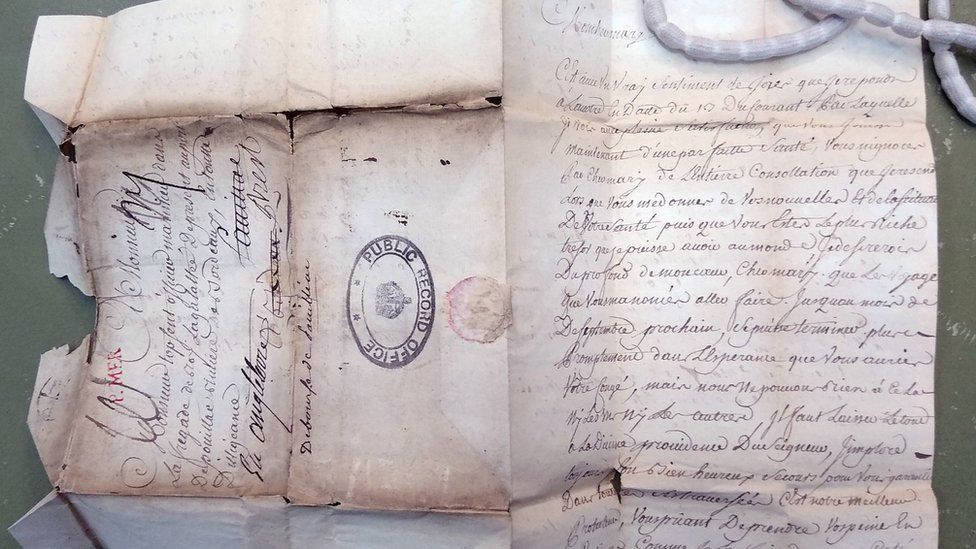 THE NATIONAL ARCHIVES
THE NATIONAL ARCHIVESLetters confiscated by Britain's Royal Navy before they reached French sailors during the Seven Years' War have been opened for the first time.
Written in 1757-8, they were sent by loved ones for crew onboard a French warship, but never reached them.
Prof Renaud Morieux, who discovered the letters, said they were about "universal human experiences".
The Seven Years' War was a battle mainly between Britain and France about control of North America and India.
It ended with the Treaty of Paris, which gave the UK considerable gains.
Prof Morieux, a University of Cambridge academic, unearthed the collection of 104 letters from the National Archives in Kew, and said it was "agonising how close they got" to reaching their intended recipients onboard the Galatee.
The French postal administration took them to multiple ports in France to attempt delivery, but were unsuccessful.
The Galatee was captured by the British on its way from Bordeaux to Quebec in 1758.
Upon learning the ship was in British hands, French authorities forwarded the letters to England, where they were handed to the navy and ended up in storage.
British Admiralty officials deemed the letters had no military significance.
Prof Morieux said he only asked to look at the box in the archives "out of curiosity" before discovering them.
"I realised I was the first person to read these very personal messages since they were written," he said.
"Their intended recipients didn't get that chance. It was very emotional," said Prof Morieux, whose findings were published in the journal "Annales. Histoire, Sciences Sociales".
Prof Morieux identified every member of the Galatee's 181-strong crew, with letters addressed to a quarter of them - he also carried out genealogical research into the men and their correspondents.
They include a letter from Marie Dubosc to her husband, the ship's first lieutenant, Louis Chambrelan.
She wrote: "I could spend the night writing to you... I am your forever faithful wife.
"Good night, my dear friend. It is midnight. I think it is time for me to rest."
Researchers say she did not know where her husband was or that his ship had been captured by the British.
He did not receive her letter and they did not meet again, with Dubosc dying the next year in northern France.
Chambrelan returned to France and remarried in 1761.
In another letter, Anne Le Cerf told her husband Jean Topsent, a non-commissioned officer: "I cannot wait to possess you."
"These letters are about universal human experiences, they're not unique to France or the 18th century," Prof Morieux said.
"They reveal how we all cope with major life challenges."
"When we are separated from loved ones by events beyond our control, like the pandemic or wars, we have to work out how to stay in touch, how to reassure, care for people and keep the passion alive.
"Today we have Zoom and WhatsApp. In the 18th century, people only had letters but what they wrote about feels very familiar."
Lost French love letters from the 1750s reveal what life was like during wartime
November 6, 2023
By Kai McNamee

The letters before they were opened.
Scores of French love letters from the mid-18th century have been opened and studied for the first time since they were written.
The letters – sent to French sailors by wives, siblings and parents – never made it to their intended recipients, but they offer rare insight into the lives of families affected by war.
"I could spend the night writing to you," wrote Marie Dubosc to her husband. "I am your forever faithful wife. Good night, my dear friend. It is midnight. I think it is time for me to rest."
Dubosc would not have known her husband had been captured by the British, and that he would never receive her message. She died the year after she sent the letter, and likely never saw him again.
Sent between 1757-58 during the Seven Years War, the letters were mostly addressed to the crew of the Galatée warship, and the French postal administration forwarded them from port to port in hopes of reaching the sailors. But when the British Navy captured the Galatée in April 1758, French authorities forwarded the batch of letters to England.
There they remained unopened for centuries, until the historian Renaud Morieux of the University of Cambridge discovered them in the digital inventory of Britain's National Archives. He checked out the box from the archives with no idea what he would find inside.
The box came with three packs of letters wrapped in white ribbon.
"I had to basically pull the string a bit like a Christmas gift," he told NPR.
"My heart started to beat faster and I felt like, 'Ooh, this looks like really cool stuff...There might be some secrets in there.'"

Anne Le Cerf's love letter to her husband Jean Topsent in which she says "I cannot wait to possess you" and signs "Your obedient wife Nanette."
The 104 letters are written on heavy, expensive paper, and some have red wax seals. But they contain the words of common people rather than aristocrats, Morieux says – voices often missing from the historical record, like sailors' and fishermens' wives.
"These letters tell us about how people from the lower classes dealt with the challenges of war and the absence of their kin and loved ones," Morieux says, "and how they managed to overcome distance and the fear of uncertainty."
Morieux spent months decoding the letters, and published his findings Monday in the French history journal Annales. Histoire, Sciences Sociales.
In one letter, Marguerite Lemoyne, a 61-year-old mother, scolds her son Nicolas Quesnel for not writing:
"On the first day of the year [i.e. January 1st] you have written to your fiancée... I think more about you than you about me...In any case I wish you a happy new year filled with blessings of the Lord. I think I am for the tomb, I have been ill for three weeks. Give my compliments to Varin [a shipmate], it is only his wife who gives me your news."
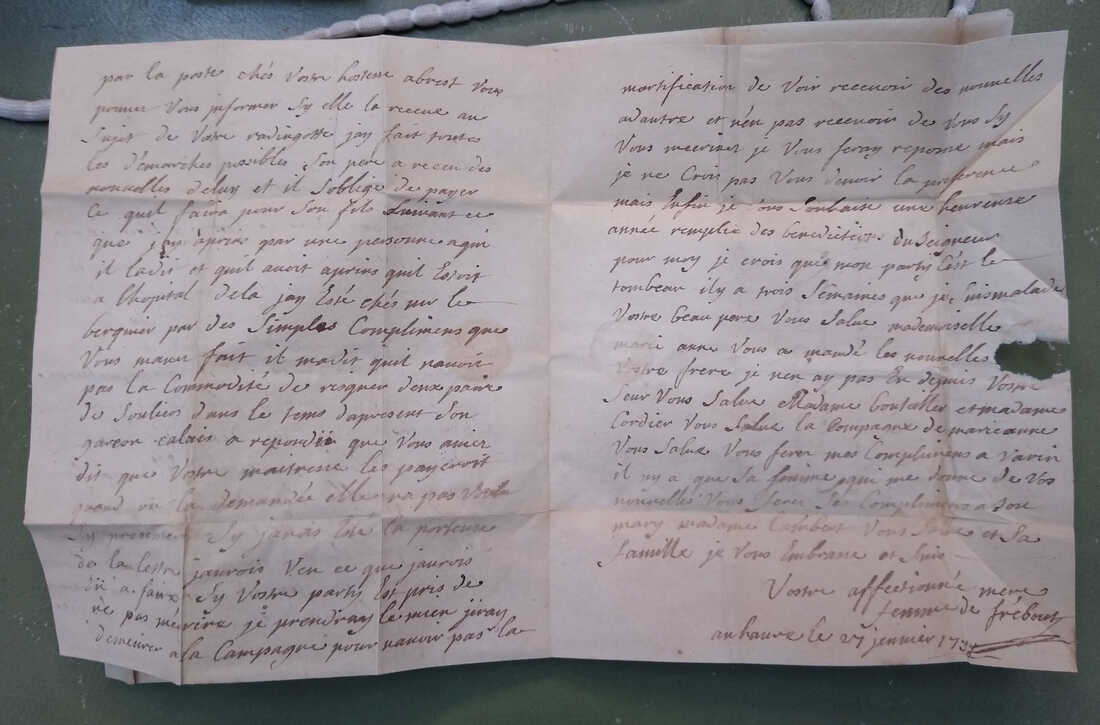
Marguerite's letter to her son Nicolas Quesnel (dated Jan. 27, 1758), in which she says, "I am for the tomb."
Morieux told NPR Lemoyne's complaint reveals "universal" family dynamics.
"The son who's at sea is only writing to his fiance, and the mother gets really pissed off about that," Morieux said. "And here you feel that there is some kind of...really long, ancient trope about tensions in the family between the mother and the daughter-in-law."
Morieux said the letters also demonstrate the difficulty of long-distance communication in the 1750s. Many of the senders, like Lemoyne, were likely illiterate and dictated their messages to a scribe.
Moreover, sending a letter to a ship constantly on the move during wartime was difficult and unreliable, and families often sent multiple copies of letters to different ports.
In an effort to maximize the chances of successfully communicating with a loved one, each letter had multiple messages crammed onto the paper, often from different families and addressed to multiple crewmates.
"And so they're covered with ink, not just from top to bottom...The sentences are written from left to right, but also they're written in the margins," Morieux said.
To Morieux, the letters show how communities stay resilient in times of crisis.
"It's about the power of the collective. It's about how these people can only survive by relying on others."
Christopher Intagliata and Gabriel Sanchez contributed to this report.

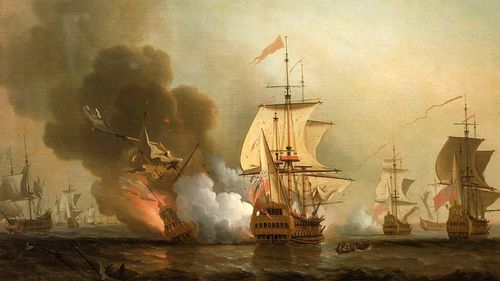
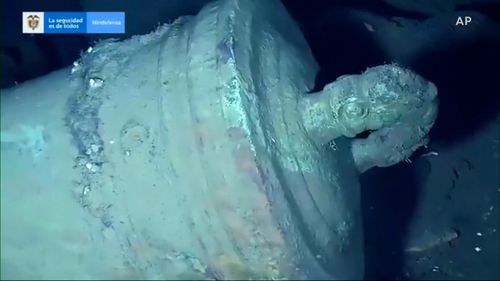

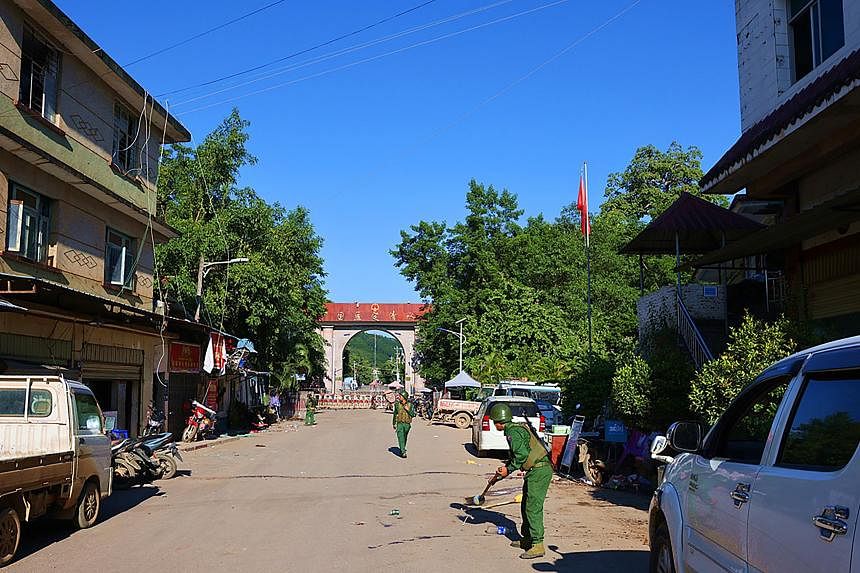




:quality(70)/cloudfront-us-east-1.images.arcpublishing.com/archetype/MIHM4JI6FJCEZP43IGRWS4FW3M.png)